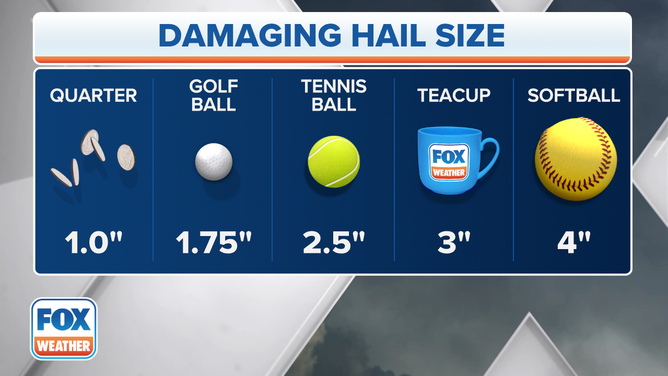How large is 'golf ball-sized' hail, and other hail measurements
The National Weather Service often estimates the hail by comparing it to a known object.
A thunderstorm is moving in and you're hearing reports from spotters that hail is moving in. Meteorologists determine the severity of the storm by the diameter of the hailstones -- the larger the hailstone, the stronger the updraft fueling the storms.
But it may be difficult to visualize offhand how large a 1/2-inch hailstone is versus an inch or two inches.
LEARN: 7 Facts About Hail
To that end, the National Weather Service often estimates the hail by comparing it to a known object. Most hailstorms are made up of a mix of different sizes, and only the very largest hailstones pose a serious risk to people caught in the open.

Common reference objects for hail stone sizes.
According to the NWS, when reporting hail, estimates comparing the hail to a known object with a definite size are good, but measurements using a ruler, calipers, or a tape measure are best. Here are the most common measurements:
- Pea = 1/4 inch diameter
- Mothball = 1/2 inch diameter
- Penny = 3/4 inch diameter
- Nickel = 7/8 inch
- Quarter = 1 inch — hail quarter size or larger is considered severe
- Ping-Pong Ball = 1 1/2 inch
- Golf Ball = 1 3/4 inches
- Tennis Ball = 2 1/2 inches
- Baseball = 2 3/4 inches
- Tea cup = 3 inches
- Softball = 4 inches
- Grapefruit = 4 1/2 inches
The largest hailstone recorded in the U.S. was 8 inches in diameter and 18.62 inches in circumference, found in Vivian, South Dakota, in 2010. That's about the size of a volleyball! It weighed nearly 2 pounds.
Golf ball- to softball-sized hail can fall at speeds ranging from 44 to 72 mph, according to the National Weather Service, while larger stones can reach 100 mph.